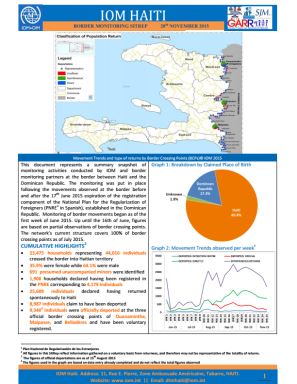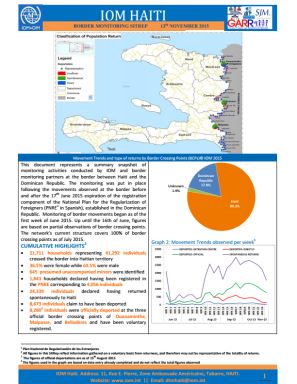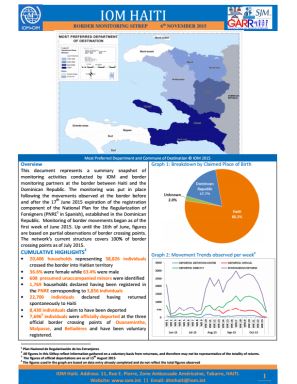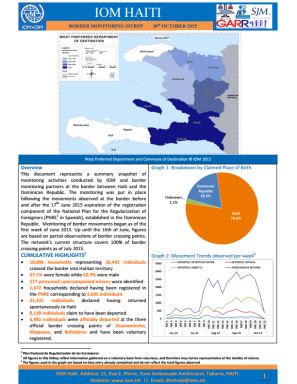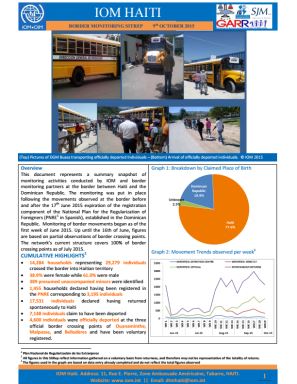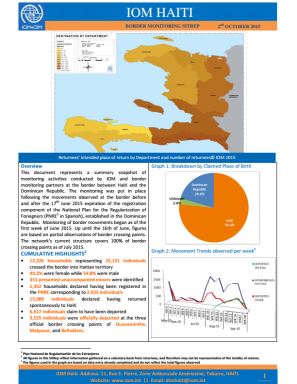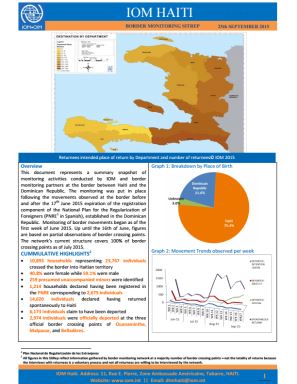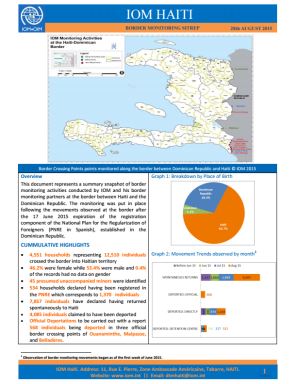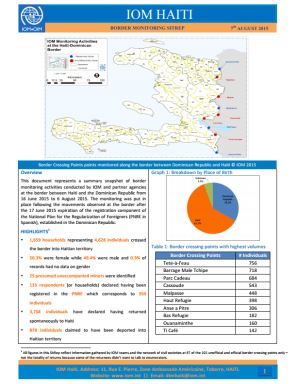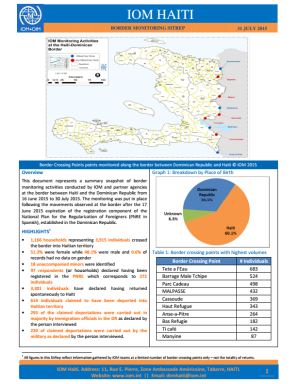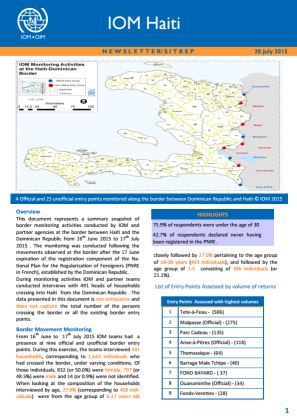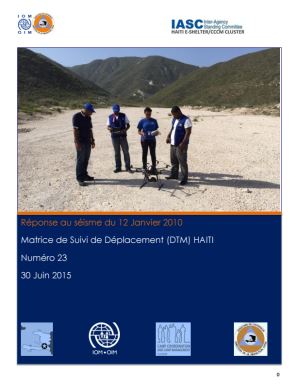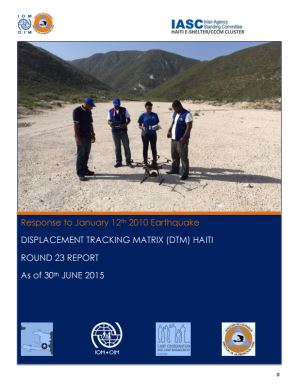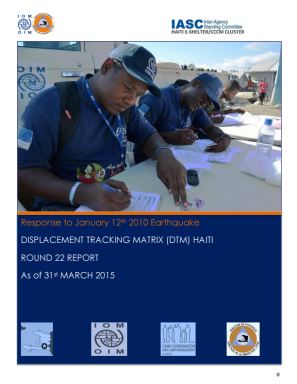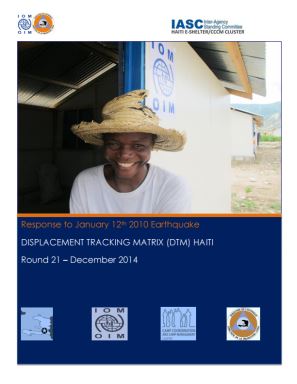-
Countries
-
Data and Analysis
-
Special Focus
-
Crisis Responses
Haiti
Suivi des PDI
Mouvements de déplacement
311,000
IDMC 2023
cycle de collecte de données
À propos Haiti
On January 12th 2010, an earthquake of 7.0 magnitude hit Haiti, resulting in the destruction of more than 300,000 buildings and the displacement of 1.5 million people. Following this destructive earthquake, and as the lead Camp Coordination/Camp Management agency, IOM took the initiative to develop a unified displacement data management process, called the Displacement Tracking Matrix (DTM). A comprehensive multi-sectoral tracking system was applied as a monitoring tool to track the IDP population on basic conditions in IDP sites, and camp-like settlements in support of the Emergency Shelter and Camp Coordination and Camp Management (E-Shelter/CCCM) Cluster and other humanitarian and recovery actors in Haiti. IOM implements the DTM in partnership with the Government of Haiti (GoH) through the Directorate of Civil Protection (DPC in French).
DTM has been adapted to the new context in the country to track humane mobility including displacement induced by gangs violence, forced returns of Haitians, migration with country in the region, especially with the Dominican Republic.
Bailleurs de fonds
- CERF
- USAID
- BHA
- ECHO
- Canada
Haiti — Border Monitoring Situation Report (20 November 2015)
Cumulatively since the first week of June to 20 November 2015, 23,475 households representing 44,016 individuals crossed the border into Haitian territory. 35.9% were female while 64.1% were male. 691 presumed unaccompanied minors were identified.
Haiti — Border Monitoring Situation Report (13 November 2015)
Cumulatively from the first week of June to 13 November 2015, 21,711 households representing 41,292 individuals crossed the border into Haitian territory. 36.5% were female while 63.5% were male. 645 presumed unaccompanied minors were identified.
Haiti — Border Monitoring Situation Report (6 November 2015)
Cumulatively from the first week of June to 6 November 2015, 20,406 households representing 38,826 individuals crossed the border into Haitian territory. 36.6% were female while 63.4% were male. 608 presumed unaccompanied minors were identified.
Haiti — Border Monitoring Situation Report (30 October 2015)
Cumulatively from the first week of June to 30 October 2015, 18,896 households representing 36,442 individuals crossed the border into Haitian territory. 37.1% were female while 62.9% were male. 577 presumed unaccompanied minors were identified.
Haiti — Border Monitoring Situation Report (16 October 2015)
Cumulatively from the first week of June to 16 October 2015, 15,612 households representing 31,595 individuals crossed the border into Haitian territory. 38.5% were female while 61.5% were male. 436 presumed unaccompanied minors were identified.
Haiti — Border Monitoring Situation Report (9 October 2015)
Cumulatively from the first week of June to 9 October 2015, 14,284 households representing 29,279 individuals crossed the border into Haitian territory. 38.9% were female while 61.0% were male. 389 presumed unaccompanied minors were identified.
Haiti — Border Monitoring Situation Report (2 October 2015)
Cumulatively from the first week of June to 2 October 2015, 12,326 households representing 26,131 individuals crossed the border into Haitian territory. 40.2% were female while 59.8% were male. 351 presumed unaccompanied minors were identified.
Haiti — Border Monitoring Situation Report (25 September 2015)
Cumulatively from the first week of June to 25 September 2015, 10,893 households representing 23,767 individuals crossed the border into Haitian territory. 40.8% were female while 59.1% were male. 259 presumed unaccompanied minors were identified.
Haiti — Border Monitoring Situation Report (18 September 2015)
Cumulatively from the start of border monitoring in the first week of June 2015 to 16 June, 9,058 households representing 20,596 individuals crossed the border into Haitian territory. 42^ were female while 57.8% were male and 0.1% of the records had no data on gender.
Haiti — Border Monitoring Situation Report (11 September 2015)
Cumulatively from the first week of June 2015 to 11 September 2015, 7,272 households representing 17,548 individuals crossed the border into Haitian territory. 43.3% were female while 56.3% were male and 0.4% of the records had no data on gender.
Haiti — Border Monitoring Situation Report (4 September 2015)
p.p1 {margin: 0.0px 0.0px 0.0px 0.0px; font: 11.0px Helvetica; color: #ff7c00} p.p2 {margin: 0.0px 0.0px 0.0px 0.0px; font: 11.0px Helvetica} span.s1 {color: #000000} span.s2 {color: #ff7c00} span.s3 {font: 10.0px Helvetica}
Haiti — Border Monitoring Situation Report (28 August 2015)
Cumulatively from 16 June 2015 to 27 August 2015, 4,551 households representing 12,510 individuals crossed the border into Haitian territory; 46.2% were female while 53.4% were male and 0.4% of the records had no data on gender; 45 presumed unaccompanied minors were id
Haiti — Border Monitoring Situation Report (21 August 2015)
Cumulatively from 16 June 2015 to 20 August 2015, 2,740 households representing 7,785 individuals crossed the border into Haitian territory; 47.3% were female while 52.4% were male and 0.3% of the records had no data on gender; 33 presumed unaccompanied minors were ide
Haiti — Border Monitoring Situation Report (14 August 2015)
Cumulatively from 16 June 2015 to 13 August 2015, 2,176 households representing 6,311 individuals crossed the border into Haitian territory; 48.3% were female while 51.3% were male and 0.4% of records had no data on gender; 25 presumed unaccompanied minors were identif
Haiti — Border Monitoring Situation Report (7 August 2015)
Cumulatively from 16 June 2015 to 6 August 2015, 1,659 households representing 4,628 individuals crossed the border into Haitian territory • 50.3% were female while 49.4% were male and 0.3% of records had no data on gender • 25 presumed unaccompanied minors were identi
Haiti — Border Monitoring Situation Report (31 July 2015)
Cumulatively from 16 June 2015 to 31 July 2015, 2,176 households representing 6,311 individuals crossed the border into Haitian territory; 48.3% were female while 51.3% were male and 0.4% of records had no data on gender; 25 presumed unaccompanied minors were identifie
Haiti — Border Monitoring Situation Report (20 July 2015)
From 16th June to 17th July 2015 IOM teams had a presence at nine official and unofficial border entry points. During this exercise, the teams interviewed 491 households, corresponding to 1,643 individuals who had crossed the border.
Haiti — Rapport de déplacement — Séisme 23 (Juin 2015)
Un séisme de magnitude 7.0 a frappé Haiti le 12 janvier 2010. Celui-ci a causé la destruction de plus de 300,000 immeubles et le déplacement de 1.5 millions de personnes. Le rapport suivant présente les résultats de visites de terrain effectuées entre le 1er Avril et le 30 Juin 2015.
Haiti — Earthquake Displacement Report 23 (June 2015)
More than 5 years after the devastating 12 January 2010 earthquake, an estimated 14,970 households or 60,801 individuals are still residing in 45 IDP sites in the earthquake affected communes. As of 30 June 2015, 45 sites remain open in Haiti.
Haiti — Earthquake Displacement Report 22 (March 2015)
More than 5 years after the devastating 12 January 2010 earthquake, an estimated 16,230 households or 64,680 individuals are still residing in 66 IDP sites in the earthquake affected communes. As of 31 March 2015, 66 sites remain open in Haiti.
Haiti — Earthquake Displacement Report 21 (December 2014)
On the eve of the fifth anniversary of the devastating 2010 earthquake, an estimated 21,218 households or 79,397 individuals still reside in 105 IDP sites. 21,218 households or 79,397 individuals still reside in camps and camp like settlements.
Haiti — Earthquake Displacement Report 20 (September 2014)
123 sites remain open, corresponding to 22,741 households or 85,432 individuals.
Haiti — Earthquake Displacement Report 19 (June 2014)
172 sites remain open, corresponding to 28,134 households or 103,565 individuals. A decrease of 33,978 IDP individuals, or 8,997 IDP households was recorded; corresponding to a 24.7% decrease in the number of individuals and 24.2% decrease in the number of households, respectively.
Haiti — Earthquake Displacement Report 18 (April 2014)
243 sites remain open corresponding to 37,131 households or 137,543 individuals. Compared to the previous assessments, a decrease of 9,382 IDP individuals or 2,439 IDP households was recorded.
Pagination
Pagination
- First page
- Previous page
- 1
- 2
- 3
- 4
- 5
- 6
- 7


